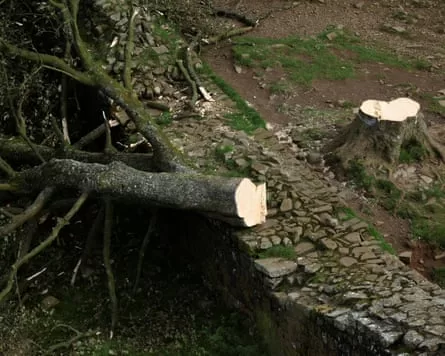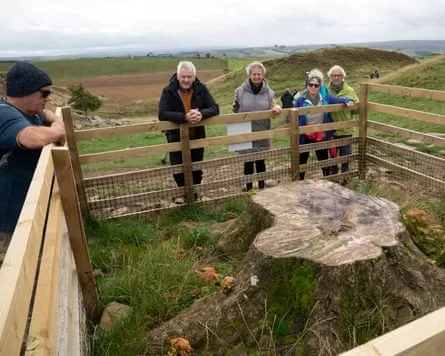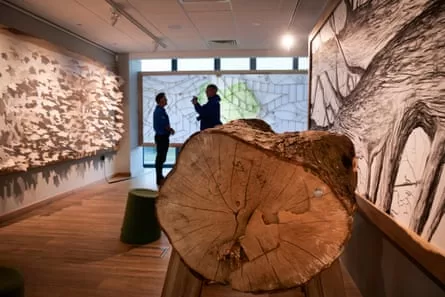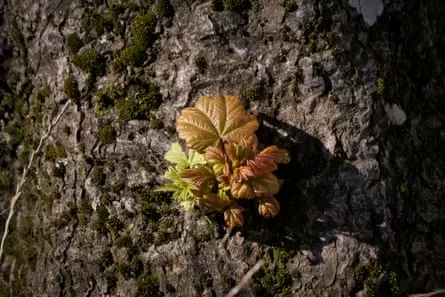“It was just a tree,” said a mystified Adam Carruthers, one of the two men who illegally cut down the tree at Sycamore Gap in the early hours of a stormy night nearly two years ago. “It was almost as if someone had been murdered.”
Carruthers was right about the reaction to the felling. Many likened its loss to that of a good friend or relative. Its destruction prompted feelings of sadness, grief and then blind fury. Some people wept.
Carruthers was wrong to see it as just a tree. It was a beautiful, life-enhancing place for countless photographs, declarations of love, engagements, birthdays and ash scatterings but it was also more than that. Many considered it part of the DNA of north-east England. Its felling was seen as a symbol of humanity’s wider war on nature. Its legacy is fast becoming one of hope and optimism.

What is certain is that none of these emotions or complexities or nuances were in the minds of Carruthers, 32, and Daniel Graham, 39, when they travelled from their homes in Cumbria over the border to Northumberland on 27 September 2023.
As Storm Agnes raged, the two friends set off in Graham’s black Range Rover Sport with a chainsaw in the boot. When they got to the tree, which has stood on Hadrian’s Wall since the late 19th century, they set about deliberately and methodically cutting it down. They apparently saw it as a laugh.
One man cut the tree down while the other filmed him on Graham’s iPhone 14.
After the footage, lasting two minutes and 40 seconds, was shown to a packed courtroom in Newcastle there was silence. It was terrible and upsetting to watch. The judge ordered a 15-minute break.
The film, enhanced by police experts, shows a silhouetted man wielding the chainsaw. Its dreadful, piercing revving echoes through the windy emptiness. After the revs comes the sound of the tree cracking and crashing down on to the wall.
It took minutes to destroy a tree which had stood for more than 100 years, the prosecutor Richard Wright KC said.
At the time of the offence, Graham lived in a caravan on land in a hamlet near Carlisle from where he ran a groundwork business. Carruthers, a father of two including a new baby, was living with his partner in a caravan in Kirkbride.
The pair became “obsessively” close friends after the death of Graham’s father. Carruthers repaired the father’s Land Rover in time for his funeral and Graham was grateful.
Graham claimed Carruthers had a “fascination” with the tree and thought it would be a good trophy. He alleged Carruthers even had a length of string in his workshop which he used to measure the tree’s circumference and kept for sentimental reasons.

After felling the tree the two men drove back and Carruthers’ partner, the mother of his newborn daughter, sent him a video of their baby being bottle-fed. Carruthers replied: “I’ve got a better video than that” before sending footage of the tree being felled.
The next day police receive a report that the tree had been damaged. People first assumed it was the result of the storm which had battered Northumberland that night.

Soon it emerged that the tree had been cut down deliberately. The tree became famous after it appeared in the film Robin Hood: Prince of Thieves with the characters played by Kevin Costner and Morgan Freeman passing under it as they walked along the wall.
Kim McGuinness, then Northumbria police and crime commissioner and now metro mayor, said the felling was like “stealing joy”. Because of time differences there are stories of people in the UK first hearing of what had happened from relatives in other parts of the world.
The first police officer on the scene was PC Peter Borini, who knew the Sycamore Gap tree well. The jury watched footage of him walking through wet grass to the felled tree and immediately treating it as a crime scene, asking people to move back and putting down tape.
As anger grew, Carruthers and Graham revelled in the headlines. Voice messages found on phones included Graham saying to Carruthers, whose nickname is Jeffrey: “Jeffrey, it’s on fucking Sky News, as we speak.” Then: “Jeffrey, it’s gone viral. It is worldwide. It will be on ITV News tonight.”
In another they made fun of a social media comment saying the perpetrators were weak.
“Weak … fucking weak? Does he realise how heavy shit is?” asked Graham.
Carruthers replied, saying he would like to see the commenter “launch an operation like we did last night. I don’t think he’s got the minerals.”
A wedge of wood which had been photographed in the back of Graham’s Range Rover was almost certainly from the Sycamore Gap tree, according to a forensic botanist.
Graham and Carruthers were first arrested and questioned on 31 October and both men denied involvement.
Graham said he had been “stitched up” and he knew who was accusing him. He said he was being framed for the crime as part of a dispute, with someone “stirring the pot”.
Both men said they did not have the skills to cut down such a large tree. Carruthers, a mechanic, said he thought chainsaws were “nasty things” and he would rather “stick with spanners”.
In the police interviews Graham refused to name who was responsible, saying he was not a “grass”.
At the trial, however, he blamed Carruthers, saying his friend had a “strange interest” in the tree. “At the time I didn’t know of the tree,” claimed Graham. “He told me it was the most famous tree in the world.”
Graham accepted that his car and his iPhone had been used in the felling of the Sycamore Gap tree but claimed he was not there, rather, he was asleep in his caravan with his dogs after taking a sleeping pill.
Carruthers, in his defence, offered no thoughts on who was responsible but insisted it was not him. He, too, was at home.
He denied sending Facebook messages to his partner while driving back from Sycamore Gap. He said he was actually sending messages while they were both in the same caravan because he did not want to wake her up.
There were other similarly implausible claims which a jury at Newcastle crown court found to be lies.
The prosecution said the pair loved how the felling of Sycamore Gap went viral. They sent message after message, revelling in their infamy. They thought themselves “funny or clever or big”, Wright said.

The tree itself was probably planted in the late 19th century by a man whose name will be familiar to anyone who knows Newcastle, where Clayton Street was once an important shopping destination. It was home to Woolworths and many clothes shops, such as Geordie Girl.
It was named after John Clayton, the city clerk who worked with the architect John Dobson and the builder Richard Grainger to redevelop Newcastle’s centre in the neoclassical style. It was Clayton’s decision to plant a sycamore tree in a dell on land he owned just because it was a beautiful spot.
According to the National Trust’s Andrew Poad: “He was an incredibly visionary man. A real unsung hero. He planted it as a landscape feature in the full knowledge he wouldn’t see it in his lifetime. He took the long-term view.”
And that view has been the driving force behind everything that has happened since the felling.

Saplings grown from seeds recovered at the site have been titled “trees of hope” and 49 of them – one for each foot of its height – have been given to good causes across the UK. They will grow at a motor neurone disease centre being named after the late rugby league star Rob Burrow and in the memory of Holly Newton, a Northumberland schoolgirl murdered by her coercive ex-boyfriend.
King Charles, the nearest school and the nation’s 15 national parks are also receiving saplings.
The tree has also been used as art, including as part of an exhibition by the artist Charlie Whinney last year.

It was never just a tree. The nature writer Robert Macfarlane sees its felling as a prompt to people to consider their relationship with the natural world.
The tree is gone and for a long time it looked like that would be that. Then last summer something remarkable happened: fragile green shoots were spotted emerging from the tree’s stump.
“To see signs of life … is astonishing,” said Poad. What view future generations have of Sycamore Gap is an unknown – but there will be one.

